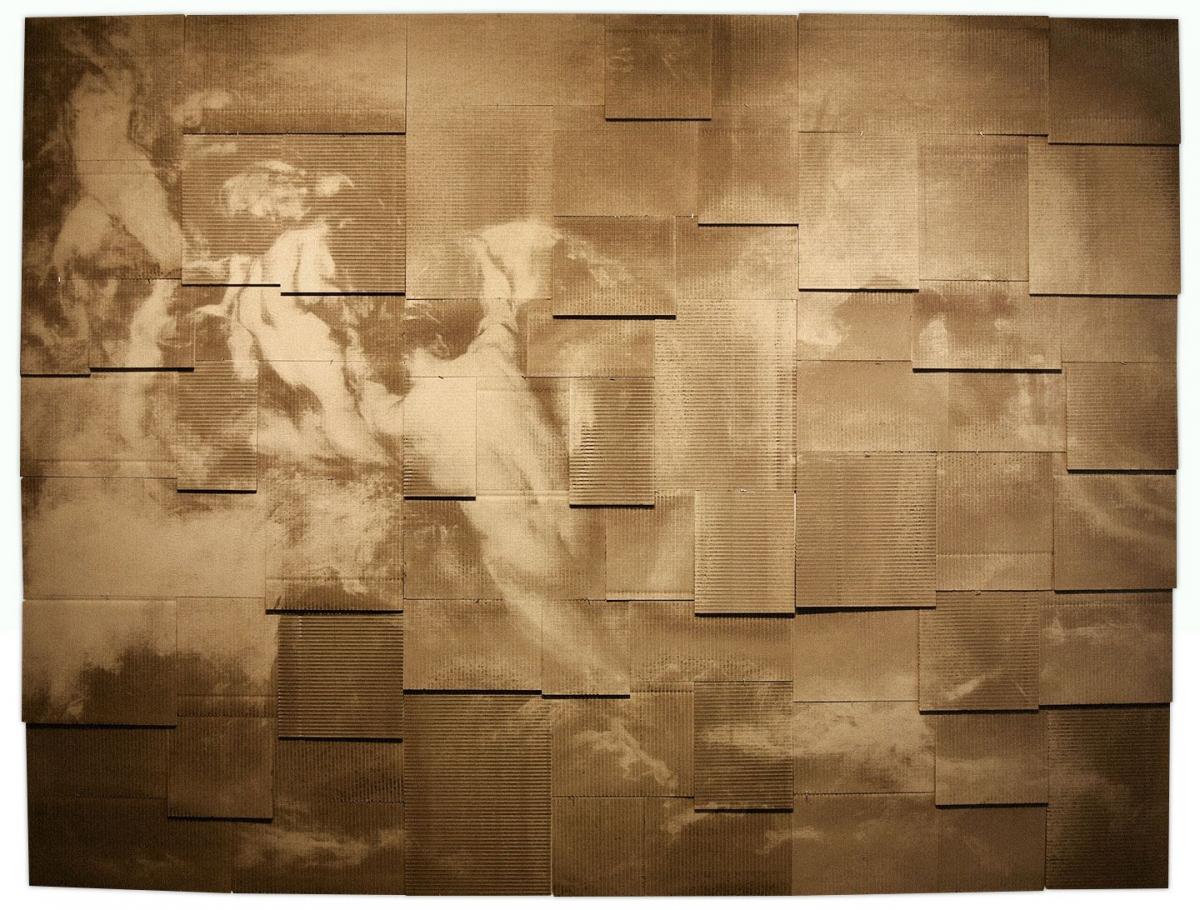The much anticipated art show in Asia, Art Basel Hong Kong, officially opens on March 29. adobo magazine had the privilege of catching up with one of this year’s participating artists, Jill Paz, for a meaningful conversation on how being a Balikbayan is translated in her art works—both physically and figuratively.

On participating in this year’s Art Basel Hong Kong
1335Mabini Gallery will be representing my work for a solo feature at Art Basel Hong Kong’s discovery section. The project is a series of a new body of work and it is a series of paintings made on cardboard from Balikbayan boxes, which is my material of choice moving back to the Philippines a year ago. The paintings are actually made up of photography computer programs and this subversion of laser technology. And so the subject matter that I’ve been looking at are works that are destroyed and particularly those by this enigmatic figure in Philippine history, Félix Resurrección Hidalgo (who also happens to be my ancestor). It’s important to note that this isn’t a project in replication; it’s a project of renovation. By looking at culture and identity through the body of work by the late painter, it’s a way of reworking my understanding of what it means to be a Filipina. So rather than looking at his body of work as this enigmatic and significant piece of history, I was looking at more as an unearthing of this marginalized story, of a marginalized figure in history.
I’ve been using cardboard material that is straight from Balikbayan boxes, a ubiquitous symbol of the Philippine diaspora. It is this prototype material, a very cheap, fragile material, and so to use that as a painting sub-straight and actually to use that as the only sub-straight and not have any other material on it but just cardboard.

(Artist: Jill Paz; Title: After Hidalgo (La Barca de Aqueronte);Year: 2018)
On the meaning and inspiration behind her work
This project really began in a piece called, “Grove of Trees” by Hidalgo, which I assume was from the early 1900s. It was destroyed in the second World War, and now, all these chips and marks are part of the painting now. My understanding of the painting is seeing it now at this point in history and not about when it was first made, that it was lost—also depicting that my family was homeless or taken by the Japanese occupation at that time. These paintings in our home were saved by my grandfather by taking them off the stretcher bars and hiding them in the mountains.
So, all you have in this beautiful masterpiece of Philippine art is like a bad jpeg, which I think is funny and ironic. Funny in a sad way, actually. So the project I have in Basel is a series of murals, like mural-sized paintings and the reason why I’m blowing up the scale, is because painting in this subject matter by this artist has resonated with me my whole life. It’s been the catalyst for me to become an artist, and to want to learn and observe and understand this world. And so by blowing it up into a larger and grander scale, it also has something to do with my remembering these paintings when I was a child when it was much bigger than it was. So, the “Artist and the Model”, and “The Grove of Trees” are two paintings that really started me on this journey of discovering what this marginalized figure in history is and also learning about my identity as a Filipina. Learning about the memory and nostalgia of Philippine art, and looking at repairing and renovation as a thematic underlying structure of putting these works together and how the process and material are also a marriage of this concept of destruction and repair.

(Jill Paz, Untitled (After Hidalgo, Las Jovenes Christians Expuestas al Populacho)
On returning to her homeland, The Philippines
I was born here [in the Philippines] and grew up in America and Canada before returning here two years ago, so being a Balikbayan has been really interesting for me; I describe it as two polarities of being engaged and estranged to one’s country. I think a lot of my work in the past couple of years has been drawn from that, from my experiences as a Balikbayan, so I connect that with the material I solely use for my project for Art Basel—the Balikbayan Box. The Balikbayan experience for me is both difficult, exciting, interesting, as it opens up a lot of possibilities as well as a lot of questions and observations, which I bring back in the art studio and into my sketchbook where I make try to make sense of it all. A catalyst for my work has been a lot about not being comfortable here (as compared to being in the States) and trying to figure out where I am coming from so a lot of the work is coming from these observations and questions of not understanding my ancestral homeland and looking at nostalgia and memory in my work.
On what comes after Art Basel Hong Kong
I’m excited to be part of this group show in Austria at this museum that’s opening in June called, The Danubiana. I think it would also be a good time to travel more. In the last couple of years, I strived so hard to make this place a home. There was no real honeymoon period for us; my husband and I had just moved here and focused on establishing a home and creating relationships. So these next few months will be a gestation period where I’m in between projects, so it would be good to travel a but more around the Philippines and explore and absorb all the information and research.
About Art Basel
Dedicated to creators and collectors of contemporary art, Art Basel is a world-renowned art fair that recognizes artists from all over the world through the support of wide-scale galleries. It has become a platform for artists and dealers to showcase and discover varieties of art since its establishment in 1970. It is hosted in three key locations: Basel in Switzerland, Miami in Florida, and Hong Kong once a year.
Art Basel Hong Kong features works from artists in Asia Pacific and other regional areas. This was founded in 2013 as a response to the rapid growth of the auction market in China and Hong Kong. In line with Art Basel’s commitment in driving careers of artists forward, it provides a platform for artists to display the cultural diversity and history of Asia, Asia-Pacific, and beyond through art. The art fair promotes the Asian art industry by safeguarding more than 240 exhibitors from all over the world.
Art Basel Hong Kong is held at the Hong Kong Convention and Exhibition Center which will run from March 29 to March 31 this year.









